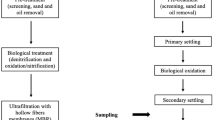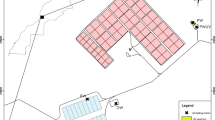Abstract
The paper provides the data of municipal wastewater pollution rate before and after treatment in Rostov-on-Don, Azov and Tsimlyansk, Russia. The aim of this paper is to assess the efficiency of inactivation and elimination pathogenic and opportunistic bacteria after treatment and disinfection. It was carried out 2640 sanitary-bacteriological tests of domestic wastewater at different treatment stages. Glucose-positive coliform bacteria (GCB), Pseudomonas aeruginosa and Klebsiella spp. were also identified as an additional indicator. The presence of Salmonella spp. and common coliform bacteria (CCB) was detected during the wastewater treatment. Pathogenic Salmonella spp. was not detected in treated wastewater samples in Rostov-on-Don and Azov. It is claimed that wastewater quality after treatment on properly functioning wastewater treatment facilities is met the country standards according to bacterial indicators (CCB, Salmonella spp.). The rate of contamination with pathogenic (Salmonella), sanitary-indicative (CCB) bacteria of the cities under the study (Rostov-on-Don, Azov, Tsimlyansk) is approximately the same and falls within the limits in accordance with Russian Standard No. 2.1.5.800–99.
Access this chapter
Tax calculation will be finalised at checkout
Purchases are for personal use only
Similar content being viewed by others
References
Zagainova, A., Yudin, S., Abramov, I., et al.: Definition of the list of potentially pathogenic and pathogenic microorganisms of bacterial, viral and parasitic nature circulating in waste and surface waters. Med. Parasitol. Parasitic Dis. 2, 50–63 (2021). https://doi.org/10.33092/0025-8326mp2021.2.50-63
State report: On the state of the environment in Russian Federation and its protection, p. 639 (2016)
Petukhova, E., Ruchkinova, O.: Dephosphorization of wastewater. PNRPU: applied ecology. Urban Dev. 2, 123–141 (2017). https://doi.org/10.15593/2409-5125/2017.02.11
Fedorov, Y., Morozova, M., Trubnik, R.: Clostridia in commercial fish of the Azov and Black seas and in Aquaculture facilities in the Southern Region of Russia. OnLine J. Biol. Sci. 19(1), 37–45 (2019). https://doi.org/10.3844/OJBSCI.2019.37.45
Petrov, A.M., Shagidullin, R.R.: Anthropogenic load on water and the problems of biological wastewater treatment. Georesources. 2(38), 14–20 (2011)
Kharkina, O.: Efficient operation and calculation of biological wastewater treatment facilities, Volgograd, Panorama, p. 463 (2015)
Zhuravlyov, P., Khutoryanina, I., Marchenko, B.: The barrier role of sewage treatment plants in relation to sanitary-indicative and pathogenic bacteria, parasitic agents on the example of the southern zone of Russia. Hyg. Sanitation. 10, 1070–1076 (2021). https://doi.org/10.47470/0016-9900-2021-100-10-1070-1076
Zhuravlyov, P., Aleshnya, V., Marchenko, B.: Determination of the disinfectant action of caustic lime on the microflora of sludge of wastewater of cleaning facilities for sewerage and cattle-breeding complexes. Hyg. Sanitation 5, 483–488 (2019). https://doi.org/10.18821/0016-9900-2019-98-5-483-488
Newton, R.J., et al.: A microbial signature approach to identify fecal pollution in the waters off an urbanized coast of Lake Michigan. Microb. Ecol. 4, 1011–1023 (2013). https://doi.org/10.1007/s00248-013-0200-9
Drury, B., Rosi-Marshall, E.J., Kelly, J.W.: A microbial signature approach to identify fecal pollution in the waters off an urbanized coast of Lake Michigan. Appl. Environ. Microbiol. 79, 1897–1905 (2013). https://doi.org/10.1128/AEM.03527-12
Nogales, B., et al.: Anthropogenic perturbations in marine microbial communities FEMS (Fed. Eur. Microbiol. Soc.). Microbiol. Rev. 35, 275–298 (2011). https://doi.org/10.1111/j.1574-6976.2010.00248.x
Anastasi, E., et al.: Pathogenic Escherichia coli found in sewage treatment plants and environmental waters. Appl. Environ. Microbiol. 78, 5536–5541 (2012). https://doi.org/10.1128/AEM.00657-12
Blaak, H.et al.: Prevalence and characteristics of ESBL-producing E. coli in Dutch recreational waters influenced by wastewater treatment plants. Vet. Microbiol. 171(3–4), 448–459 (2014). https://doi.org/10.1016/j.vetmic.2014.03.007
Cui, Q., et al.: Diversity and abundance of bacterial pathogens in urban rivers impacted by domestic sewage. Environ. Pollut. 249, 24–35 (2019). https://doi.org/10.1016/j.envpol.2019.02.094
Morozova, M., Mirzoyan, A.: Ecological features of bacteriocenosis ichthyofauna in natural conditions and in aquaculture Lower Don. Fundam. Res. 8(12), 1672–1676 (2014)
Byappanahalli, M., et al.: Enterococci in the environment. Microbiol. Mol. Biol. Rev. 76, 685–706 (2012). https://doi.org/10.1128/MMBR.00023-12
Percival, S.L., Yates, M.V., Williams, D., Chalmers, R., Gray, N.: Microbiology of waterborne diseases: microbiological aspects and risks, 696. Academic Press, New York (2013)
Hlavsa, M.C., et al.: Outbreaks of Illness associated with recreational water-United States, 2011–2012. Morb. Mortal. Wkly Rep. 64(24), 668–672 (2015). https://doi.org/10.1111/ajt.13473
Rakhmanin, Y., et al.: Distribution of bacteria of the Klebsiella strain in water objects and their value in developing of the water caused acute intestinal infections. Hyg. Sanitation 95(4), 397–406 (2016). https://doi.org/10.18821/0016-9900-2016-95-4-397-406
Zhuravlyov, P., et al.: Assessment of the microbial risk of bacterial intestinal infections transmitted by water (on the example of the cities of the Rostov region). Infect. Immun. 2(1–2), 144 (2012)
Zagainova, A., Rakhmanin, Y.: Development of approaches to an estimation of risk of occurrence of the bacterial intestinal infections distributed by a waterway. World Sci. Cult. Educ. 4–2(29), 268–273 (2012)
Zhuravlyov, P., Aleshnya, V.: Microbial risk of waterborne bacterial intestinal infections in recreational water use. Peculiarities of metabolism at adaptation and alteration. Days of Molecular Medicine on the Don, pp. 102–104 (2018)
Sedova, D., Romanovskaya, J.: Enzymes of pathogenicity, sensitivity to antibiotics and commercial preparations of bacteriophages of Klebsiella pneumoniae strains isolated from the water of the Lower Don. Ecology of the Own Land: Problems and Ways to Solve Them, pp. 67–70 (2021)
Zhuravlyov, P., et al.: Antibiotic resistance of bacteria isolated from the water of open reservoirs. Publ. Health Life Environ. 5(266), 24–26 (2015)
Aleshnya, V et al.: Effect of active chlorine on the inactivation of indicator microorganisms. Environmental Problems of Modernity: Identification and Prevention of the Adverse Impact of Anthropogenically Determined Factors and Climate Change on the Environment and Public health, pp. 23–26 (2017)
Savin, M., et al.: Antibiotic-resistant bacteria, antibiotic resistance genes, and antibiotic residues in wastewater from a poultry slaughterhouse after conventional and advanced treatments. Sci. Rep. 11(1), 1–11 (2021). https://doi.org/10.1038/s41598-021-96169-y
Shaikhutdinova, A., Kuksanov, V., Knyazeva, A.: Study of the efficiency of cleaning domestic wastewater in the city of Orenburg. Bull. Orenburg State Agrarian Univ. 4(66), 240–243 (2017)
Bunkova, E., Evtyukhina, I.: Analysis of the effectiveness and prospects for the development of a biological wastewater treatment system (on the example of Orenburg). Questions Sci. Educ. 1(42), 11–16 (2019)
Author information
Authors and Affiliations
Corresponding author
Editor information
Editors and Affiliations
Rights and permissions
Copyright information
© 2023 The Author(s), under exclusive license to Springer Nature Switzerland AG
About this paper
Cite this paper
Zhuravlev, P., Morozova, M., Sedova, D., Zubtsov, V. (2023). The Barrier Role of Wastewater Treatment Plants Against Opportunistic Bacteria. In: Beskopylny, A., Shamtsyan, M., Artiukh, V. (eds) XV International Scientific Conference “INTERAGROMASH 2022”. INTERAGROMASH 2022. Lecture Notes in Networks and Systems, vol 574. Springer, Cham. https://doi.org/10.1007/978-3-031-21432-5_323
Download citation
DOI: https://doi.org/10.1007/978-3-031-21432-5_323
Published:
Publisher Name: Springer, Cham
Print ISBN: 978-3-031-21431-8
Online ISBN: 978-3-031-21432-5
eBook Packages: EngineeringEngineering (R0)




